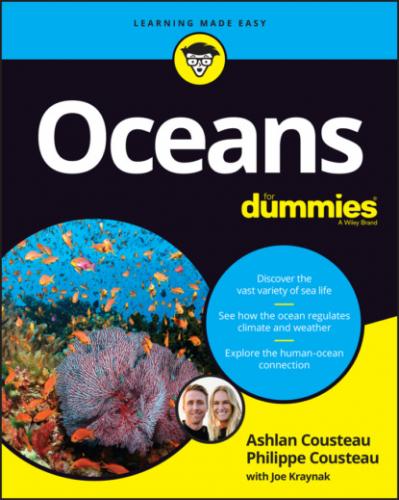Wading through the neritic zone
When you start to need some sort of flotation device (or a boat) to keep your head above water, you’re in the neritic zone (also known as the sublittoral zone). This area starts at the low tide mark and continues to the edge of the continental shelf in the ocean — about 200 meters (660 feet) deep. While that may sound really deep, it’s relatively shallow compared to how deep it gets out in the open ocean, which is much, much, much deeper.
Biodiversity is at its peak in the neritic zone, and no wonder — everyone wants to live here! Virtually every marine plant and thousands of coastal animal species (vertebrates and invertebrates) call this zone home. Consequently, the neritic zone is where 90 percent of all marine life resides. Diverse ecosystems flourish in and around coral reefs, seagrass beds, and kelp forests, all of which rely on sunlight-powered photosynthesis.
Why is it such a popular place? Well, conditions in the neritic zone are ideal for supporting diverse marine communities — the presence of sunlight throughout the zone; moderate, stable temperatures, pressures, and salinity; plenty of oxygen and carbon dioxide; and an abundance of nutrients that make their way from the land into the ocean (which under normal circumstances is good but can be bad when it’s too much).
In fact, the neritic zone is such a pleasant place, it’s also a popular hangout for sea creatures that move between deeper open ocean and shallow coastal waters, such as some sharks, turtles, and dolphins. And that’s not all — common visitors include those that feed in coastal waters but can also haul out onto land, such as some marine reptiles, pinnipeds (seals, sea lions, walruses), and penguins.
Heading out to sea: The oceanic zone
The rest of the ocean that is neither intertidal nor neritic accounts for the oceanic zone. This vast, deep, inground pool comprises a huge chunk of Earth. It actually accounts for 95 percent of all the living space on the planet. Yet, it’s the part of the ocean (and part of the planet) we know the least about.
It starts from the edge of the continental shelf (the outer edge of the neritic zone) and extends all the way down to the seafloor 11,064 meters (36,300 feet) at its deepest point at the bottom of the Mariana (or Marians) Trench. In fact, it’s so deep, it had to be divided into zones, but let’s not get too deep into that here; depth is the topic of the next section.
While the diversity of species in the oceanic zone can’t hold a candle to the diversity in the neritic zone, the contrast in how life survives at the top and bottom of this zone can’t be beat. Near the surface, where sunlight penetrates, plants anchor the food webs and ecosystems. In contrast, on the seafloor, where it’s pitch black, ecosystems depend on either the remains of organisms that settle to the bottom or life that develops around hydrothermal vents and the bacteria that dine on the chemicals spewing from those vents.
So, what sort of life exists in the oceanic zone? Keep reading.
Despite the oceanic zone’s enormity, it’s actually considered to be a marine desert because it’s so sparsely populated. When comparing the size of the oceanic zone to the number of species it contains, biodiversity here is relatively low.
Exploring the Five Vertical Zones of the Water Column
The ocean’s water column (a conceptual pillar of water measured from the ocean’s surface to the seafloor) is often divided into five zones — the epipelagic, mesopelagic, bathypelagic, abyssopelagic, and hadalpelagic zones (see Figure 4-2). The divisions generally correspond to differences in depth, amount of sunlight, temperature, pressure, nutrients, and organisms that live in those zones. In the following sections, we take a deep dive into each of the five vertical ocean zones.
©John Wiley & Sons, Inc.
FIGURE 4-2: The ocean’s vertical zones.
Skimming the surface: The epipelagic zone
The epipelagic zone (commonly referred to as the sunlight zone) is the top 200 meters (about 650 feet) of the ocean, where enough sunlight is available for plant life to grow and support a large, diverse population of marine life. Because it forms the ocean’s surface, the epipelagic zone experiences greater variations (compared to the other vertical zones) in temperature and other conditions due to climate, local weather patterns, and proximity to large land masses.
Who lives here? Lots of plankton (tiny plants and animals that float, as shown in Figure 4-3); nekton (tiny plants and animals that swim); jellyfish; sea turtles (see Figure 4-4); a variety of fish including tuna (see Figure 4-5), marlin, salmon, and sharks; and cetaceans (dolphins and whales).
Courtesy of Christian Sardet/CNRS/Tara expeditions, from Plankton—Wonders of the Drifting World, Univ Chicago Press 2015. Licensed under CC BY-SA 4.0
FIGURE 4-3: Plankton.
Dimming the lights in the mesopelagic zone
Just below the epipelagic zone is the mesopelagic zone (commonly referred to as the twilight zone). This is the region spanning 200 to 1,000 meters (650 to 3,300 feet) below the surface, where some sunlight still penetrates, but not enough for photosynthesis. To feed, most animals in this zone move toward the surface. Others eat whatever detritus (table scraps) and organic matter fall from the epipelagic zone, or they just eat their smaller or weaker twilight zone neighbors.
Source: Cristina Mittermeier – www.sealegacy.org
FIGURE 4-4: Sea turtle.
